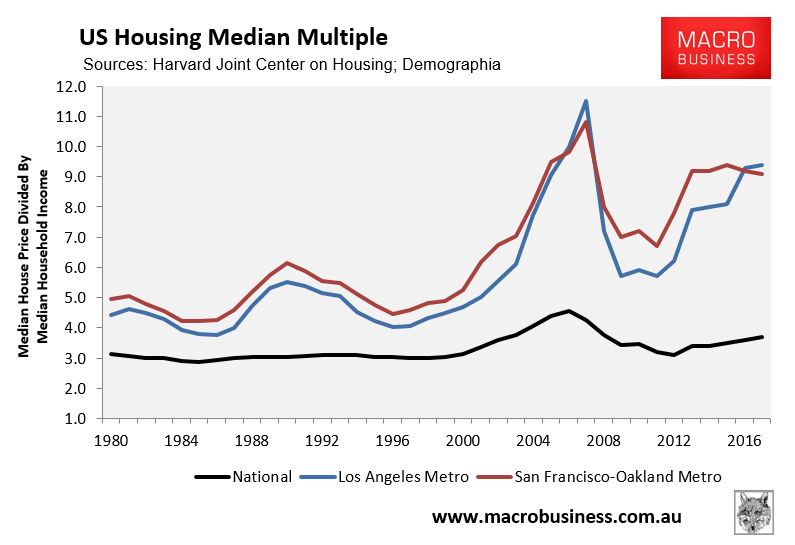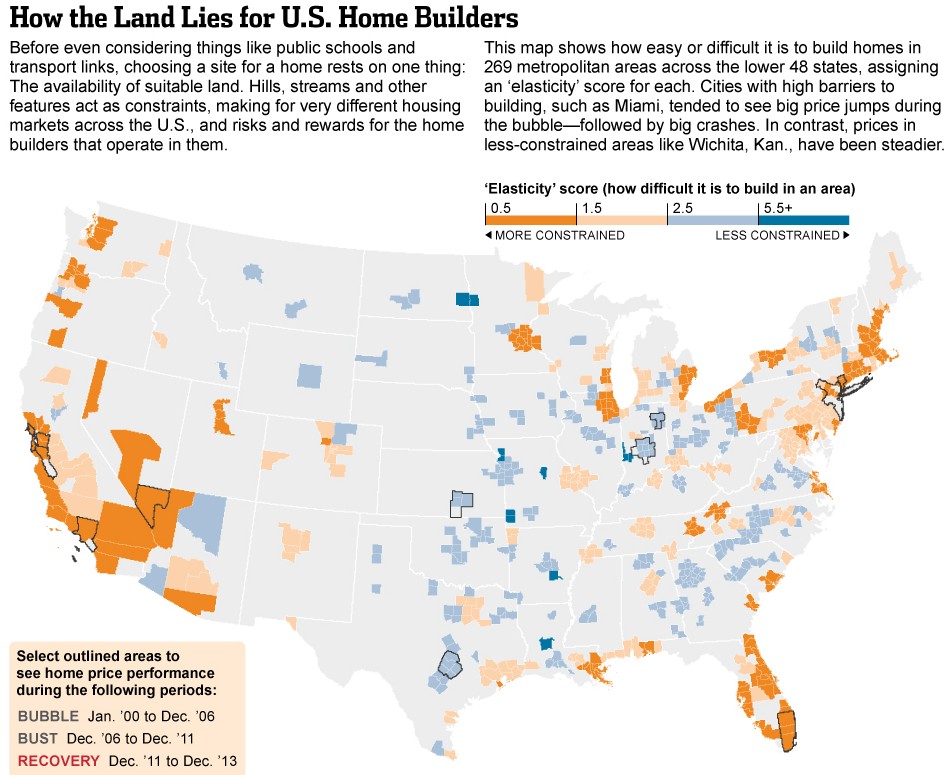For years I have argued that markets where land supply is unresponsive (inelastic) – via planning constraints or geographical barriers – are far more prone to suffer from more expensive housing, higher house price volatility, and bigger boom and bust cycles than markets where land supply is relatively responsive (elastic) to changes in price.
These dynamics were explained in detail in my 2013 presentation to a mortgage risk roundtable in Melbourne (available for download here).
In essence, housing markets where strict regulatory barriers are in place – such as urban growth boundaries, restrictive planning/zoning requirements, minimum lot sizes, and upfront development taxes – are incapable of quickly and efficiently supplying low-cost housing.
These supply constraints thereby ensure that increases (decreases) in housing demand feed primarily into higher (lower) prices instead of changes in affordable new construction.
The perceived land/housing shortages and rising prices during the upswing also encourages speculative demand and ‘panic buying’ from first-time buyers, which assists in driving home prices up even further. However, when the economy and sentiment sour, such as in the wake of the financial crisis in the US, the slump in housing demand can cause prices to collapse.
The Los Angeles and San Francisco Bay Area metropolitan areas are a classic example of how land-use constraints have caused house prices to be both volatile and expensive:

California has operated strict growth management (“smart growth”) policies since the 1970s, whereas Los Angeles and San Francisco are also hemmed in to a degree by the ocean, mountains and in the case of Los Angeles the Mexican border to the south. This has cause housing supply to be unresponsive to changes in demand, with frequent boom and bust cycles and unaffordable housing the result.

Last year, Los Angeles residents sought to ban major developments, in a move that was certain to further stifle supply, increase price volatility, and make housing even less affordable. From the Wall Street Journal:
Voters in the second-largest U.S. city are considering a measure that could effectively halt major real-estate projects…
Many longtime residents have become resentful of new towers that cast shadows over their neighborhoods of single-family homes and push up rents…
Now some activists are pushing back with actions that threaten to grind housing production in some cities to a crawl… The moves threaten to further constrict a tight supply of housing…
In Los Angeles, residents in early March are set to vote on a ballot initiative that, if passed, would suspend for two years any development that requires a modification to the city’s existing planning rules. Currently, such modifications are routine for new developments…
Despite complaints in Los Angeles about a deluge of development, housing construction now is at only a fraction of the rate of the mid-20th century, before strict zoning rules were put in place. From 1950 through 1959, about 250,000 units of new housing were added in the city of Los Angeles, according to an analysis of census data by advocacy group Abundant Housing LA. From 2010 to 2015, the figure was 25,000, though the city issued permits for about 50,000 units in roughly the same period…
Now VOX reports that a sweeping new bill called SB 827 will be introduced to tackle California’s housing supply problem, which is at crisis levels:
California is in the midst of crippling housing crisis. The state’s population has steadily grown, but it hasn’t been building new places for people to live at anything close to the same rate. It now ranks 49th in housing units per capita.
The predictable consequence of demand growing faster than supply is that existing housing in the state, especially in its biggest cities, has become insanely expensive. Seven of the 10 most expensive US real estate markets are Californian. The median home price in the state is $524,000; in San Francisco it is approaching $1.3 million…
The basic problem remains: It is difficult to build housing in California, thanks in part to a thicket of local parking regulations, building requirements, zoning restrictions, and bureaucratic choke points…
Now, there is a solution on the table that goes directly after this root cause. SB 827, a new bill before the California Senate, would require that all areas within a half-mile of a high-frequency transit stop, or within a quarter-mile of a bus or transit corridor, allow heights of at least 45 or 85 feet (depending on distance from transit, width of street, and other characteristics). That’s roughly four to eight stories, far higher than what many local zoning commissions allow.
SB 827 would also waive any minimum parking requirements in those areas and prohibit any design requirement that would have the effect of arbitrarily lowering the square footage allowed on a lot.
The bill’s changes would apply to huge swathes of the state, including the majority of land in several major cities. It would unleash dense development In markets long dominated by powerful anti-housing activists (often called NIMBYs, for Not In My Backyard). It represents a housing revolution…
What remains to be seen is how the state’s powerful low-income and social-justice community will come down on it. Recently, a coalition of such groups sent Wiener a letter opposing the bill, based on fears that development will displace low-income residents near transit, increasing housing stock but exacerbating inequality. At present, the bill contains no explicit measures to prevent such displacement.
What I find interesting about this issue is that “over-development” is really a symptom of the pressures from population growth, which itself is driven mostly by immigration. And yet Californian residents overwhelming supported (2-to-1) Hilary Clinton during the US Presidential Election, who was in favour of mass immigration, whereas Donald Trump was opposed.
It seems contradictory for Californians to be supporters of mass immigration while at the same time decrying development, since they go hand-in-hand. The marginalised youth in California can’t seem to bring themselves to call for managed population growth so that they can have a roof over their heads.

